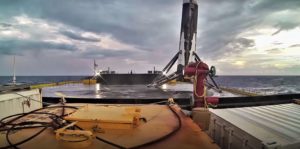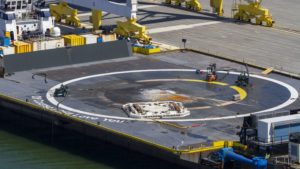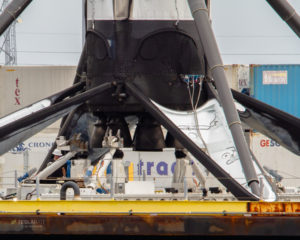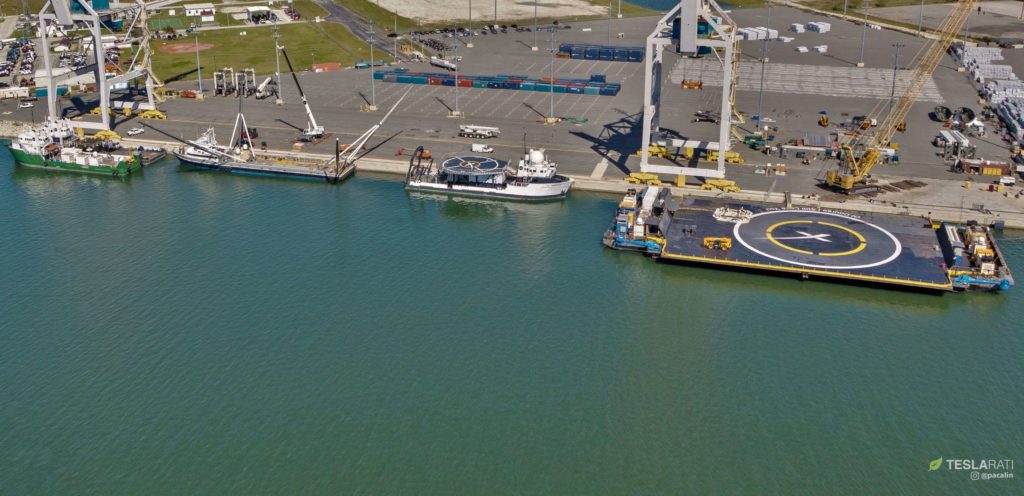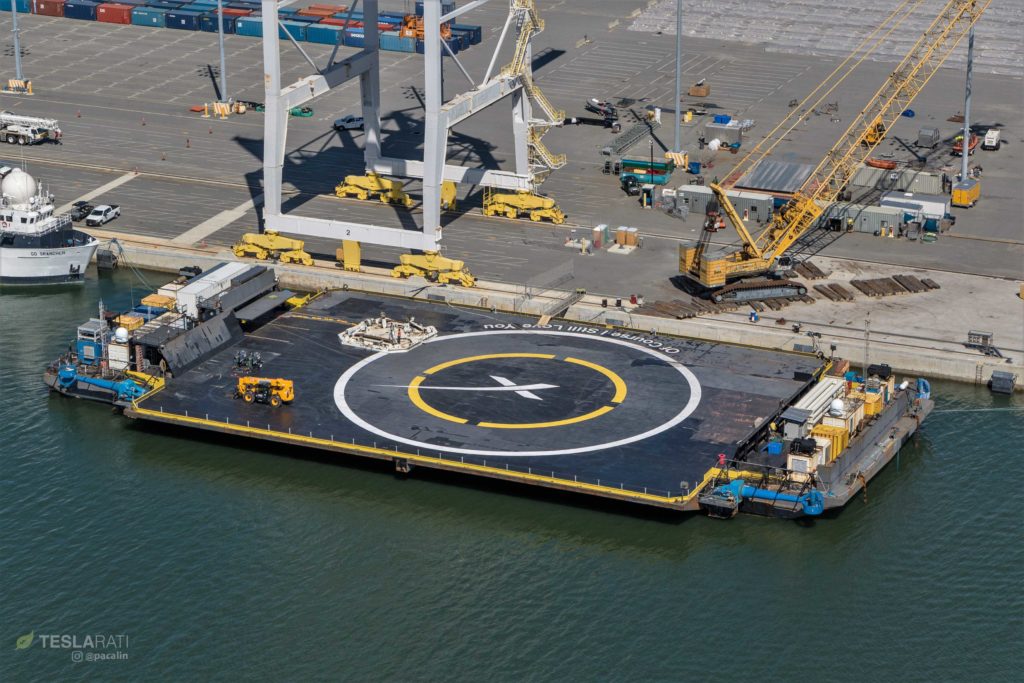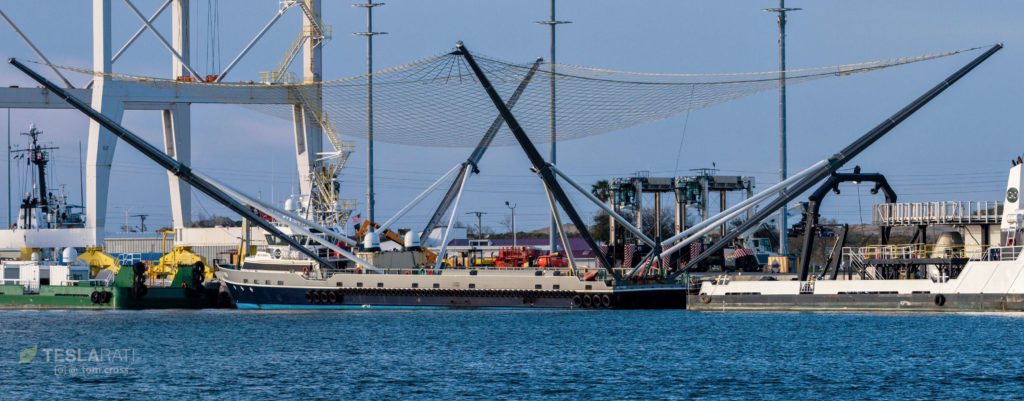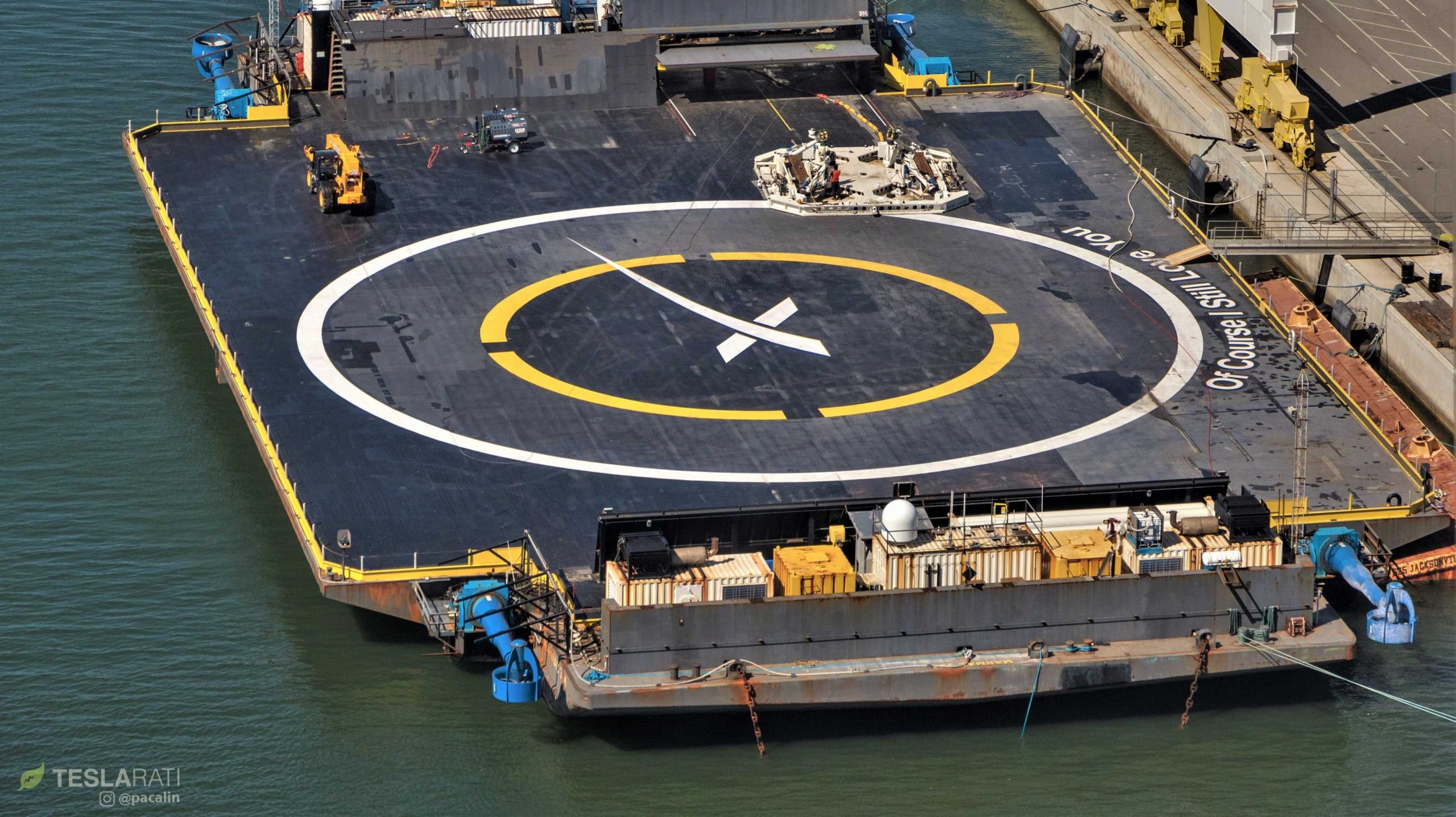
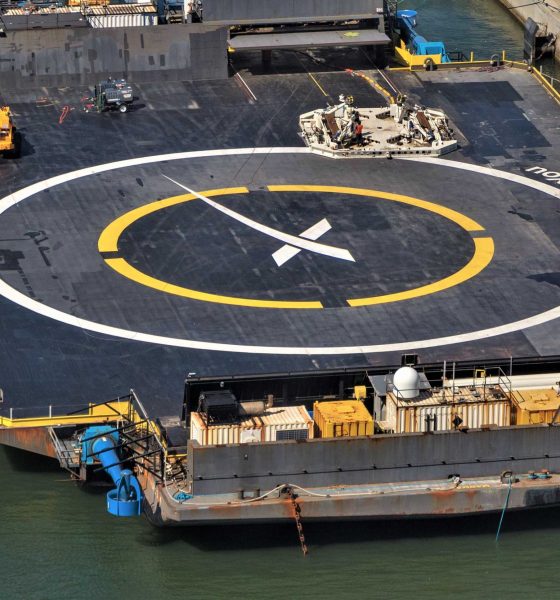
SpaceX
SpaceX’s Falcon 9 recovery robot prepares for imminent rocket landing [photos]
SpaceX’s shadow-bound Falcon 9 recovery robot was spotted out and about aboard drone ship Of Course I Still Love You (OCISLY) in the week leading up to the company’s next rocket launch, targeting liftoff at 8:45 pm EST (01:45 UTC), February 21st.
Dedicated to safely securing Falcon 9 and Heavy boosters after landing aboard drone ship OCISLY, the robot – unofficially nicknamed Octagrabber – uses four hydraulic arms and the sheer mass of its solid steel frame to grab onto the ~25-ton boosters’ built-in launch clamps and hold them steady in sea states that would create a hazard for recovery technicians. Effectively a rocket-grabbing robotic tank, Octagrabber will likely play a role in Falcon 9 B1048’s imminent third launch and landing.
Octagrabber with human for scale. 2/14 #spacex pic.twitter.com/JmUYDJubRm
— Pauline Acalin (@w00ki33) February 15, 2019
While Octagrabber’s work tends to take a backseat to the building-sized rocket landings it precedes, the robot has played an important role in SpaceX’s Falcon 9 recovery efforts since it went into service in mid-2017. Its development was expedited in part because of an iffy 2016 rocket recovery in which the Falcon 9 booster in question – destined to eventually become one of Falcon Heavy’s two side cores – landed hard and wound up precariously sliding around the deck of OCISLY, only saved from falling overboard by the lip of the drone ship’s deck.
- B1023 slid around OCISLY’s deck shortly after launch, nearly falling into the Atlantic. (SpaceX)
- SpaceX’s rocket-securing robot, known as Octagrabber, seen on OCISLY after another successful rocket recovery, August 12th. (Tom Cross)
- Octagrabber hangs on to B1046 as OCISLY arrives in port. (Tom Cross)
With a 25-ton, ~150-foot tall pressurized rocket sliding uncontrollably around their work area, SpaceX’s recovery technicians understandably extricated themselves from the situation and were forced to wait for calmer seas before securing the booster to the deck. Aside from a period of a few months in late 2017 where Octagrabber was effectively incinerated while attempting to secure a Falcon 9 booster with a fuel leak, the robot has been a part of nearly every East Coast Falcon 9 drone ship recovery since. The overall value it adds is unclear but the fact that a similar sibling has yet to be built for West Coast drone ship Just Read The Instructions (JRTI) suggests that Octagrabber is viewed as more of a good option to have with an otherwise non-critical level of utility.
Nevertheless, the lone robot continues to soldier on and is routinely spotted out and about on OCISLY’s deck while the drone ship is docked in Port Canaveral, presumably performing a variety of maintenance checkouts and testing hardware and software between rocket recoveries. While SpaceX’s 2019 launch manifest has had a slow start in January and February, things are expected to get quite a bit more active over the next few months, while a SpaceX executive recently indicated that the company was hoping to conduct 21 or more launches this year.
- (Pauline Acalin)
- (Pauline Acalin)
- Mr. Steven is seen here in Port Canaveral on February 15th, one week before the… accident… (Tom Cross)
Up next on SpaceX’s manifest is a launch just over 12 hours from now, featuring communications satellite PSN-6, an Air Force smallsat, and the first commercial Moon lander. If all goes as planned, the ~5400 kg (11,900 lb) trio will be placed into a high-energy geostationary transfer orbit with an apoapsis around 60,000 km (~38,000 mi) above Earth’s surface. Eight and a half minutes after launch, Falcon 9 B1048 will attempt its third landing in seven months, hopefully setting itself up for a fourth flight (and beyond) later this year. Mr. Steven – having completed a 5000 mile (8000 km) journey just a week and a half prior – will also attempt the first East Coast Falcon fairing catch.
Check out Teslarati’s newsletters for prompt updates, on-the-ground perspectives, and unique glimpses of SpaceX’s rocket launch and recovery processes!

News
SpaceX shades airline for seeking contract with Amazon’s Starlink rival

SpaceX employees, including its CEO Elon Musk, shaded American Airlines on social media this past weekend due to the company’s reported talks with Amazon’s Starlink rival, Leo.
Starlink has been adopted by several airlines, including United Airlines, Qatar Airways, Hawaiian Airlines, WestJet, Air France, airBaltic, and others. It has gained notoriety as an extremely solid, dependable, and reliable option for airline travel, as traditional options frequently cause users to lose connection to the internet.
Many airlines have made the switch, while others continue to mull the options available to them. American Airlines is one of them.
A report from Bloomberg indicates the airline is thinking of going with a Starlink rival owned by Amazon, called Leo. It was previously referred to as Project Kuiper.
American CEO Robert Isom said (via Bloomberg):
“While there’s Starlink, there are other low-Earth-orbit satellite opportunities that we can look at. We’re making sure that American is going to have what our customers need.”
Isom also said American has been in touch with Amazon about installing Leo on its aircraft, but he would not reveal the status of any discussions with the company.
The report caught the attention of Michael Nicolls, the Vice President of Starlink Engineering at SpaceX, who said:
“Only fly on airlines with good connectivity… and only one source of good connectivity at the moment…”
CEO Elon Musk replied to Nicolls by stating that American Airlines risks losing “a lot of customers if their connectivity solution fails.”
American Airlines will lose a lot of customers if their connectivity solution fails
— Elon Musk (@elonmusk) December 14, 2025
There are over 8,000 Starlink satellites in orbit currently, offering internet coverage in over 150 countries and territories globally. SpaceX expands its array of satellites nearly every week with launches from California and Florida, aiming to offer internet access to everyone across the globe.
Currently, the company is focusing on expanding into new markets, such as Africa and Asia.
News
Tesla hints at Starlink integration with recent patent
“By employing polymer blends, some examples enable RF transmission from all the modules to satellites and other communication devices both inside and outside the vehicle.”

Tesla hinted at a potential Starlink internet terminal integration within its vehicles in a recent patent, which describes a vehicle roof assembly with integrated radio frequency (RF) transparency.
The patent, which is Pub. No U.S. 2025/0368267 describes a new vehicle roof that is made of RF-transparent polymer materials, allowing and “facilitating clear communication with external devices and satellites.”
Tesla believes that a new vehicle roof design, comprised of different materials than the standard metallic or glass elements used in cars today, would allow the company to integrate modern vehicular technologies, “particularly those requiring radio frequency transmission and reception.
Tesla has recently filed a US patent application on integrating RF transparent materials into the roof structure.
“facilitating clear communication with external devices and satellites”
Tesla fleet is getting @Starlink connectivity integration soon. LFG @Tesla @elonmusk… pic.twitter.com/bLa8YtPLd1
— Chansoo Byeon (@Chansoo) December 9, 2025
Instead of glass or metallic materials, Tesla says vehicles may benefit from high-strength polymer blends, such as Polycarbonate, Acrylonitrile Butadiene Styrene, or Acrylonitrile Styrene Acrylate.
These materials still provide ideal strength metrics for crashworthiness, stiffness for noise, vibration, and harshness control, and are compliant with head impact regulations.
They would also enable better performance with modern technologies, like internet terminals, which need an uninterrupted signal to satellites for maximum reception. Tesla writes in the patent:
“By employing polymer blends, some examples enable RF transmission from all the modules to satellites and other communication devices both inside and outside the vehicle.”

One of the challenges Tesla seems to be aware of with this type of roof design is the fact that it will still have to enable safety and keep that at the forefront of the design. As you can see in the illustration above, Tesla plans to use four layers to increase safety and rigidity, while also combating noise and vibration.
It notes in the patent that disclosed examples still meet the safety requirements outlined in the Federal Motor Vehicle Safety Standards (FMVSS).
Starlink integrated directly into Tesla vehicles would be a considerable advantage for owners. It would come with a handful of distinct advantages.
Initially, the inclusion of Starlink would completely eliminate cellular dead zones, something that is an issue, especially in rural areas. Starlink would provide connectivity in these remote regions and would ensure uninterrupted service during road trips and off-grid adventures.
It could also be a critical addition for Robotaxi, as it is crucial to have solid and reliable connectivity for remote monitoring and fleet management.
Starlink’s growing constellation, thanks to SpaceX’s routine and frequent launch schedule, will provide secure, stable, and reliable internet connectivity for Tesla vehicles.
Although many owners have already mounted Starlink Mini dishes under their glass roofs for a similar experience, it may be integrated directly into Teslas in the coming years, either as an upgrade or a standard feature.
Investor's Corner
SpaceX IPO is coming, CEO Elon Musk confirms
However, it appears Musk is ready for SpaceX to go public, as Ars Technica Senior Space Editor Eric Berger wrote an op-ed that indicated he thought SpaceX would go public soon. Musk replied, basically confirming it.

Elon Musk confirmed through a post on X that a SpaceX initial public offering (IPO) is on the way after hinting at it several times earlier this year.
It also comes one day after Bloomberg reported that SpaceX was aiming for a valuation of $1.5 trillion, adding that it wanted to raise $30 billion.
Musk has been transparent for most of the year that he wanted to try to figure out a way to get Tesla shareholders to invest in SpaceX, giving them access to the stock.
He has also recognized the issues of having a public stock, like litigation exposure, quarterly reporting pressures, and other inconveniences.
However, it appears Musk is ready for SpaceX to go public, as Ars Technica Senior Space Editor Eric Berger wrote an op-ed that indicated he thought SpaceX would go public soon.
Musk replied, basically confirming it:
As usual, Eric is accurate
— Elon Musk (@elonmusk) December 10, 2025
Berger believes the IPO would help support the need for $30 billion or more in capital needed to fund AI integration projects, such as space-based data centers and lunar satellite factories. Musk confirmed recently that SpaceX “will be doing” data centers in orbit.
AI appears to be a “key part” of SpaceX getting to Musk, Berger also wrote. When writing about whether or not Optimus is a viable project and product for the company, he says that none of that matters. Musk thinks it is, and that’s all that matters.
It seems like Musk has certainly mulled something this big for a very long time, and the idea of taking SpaceX public is not just likely; it is necessary for the company to get to Mars.
The details of when SpaceX will finally hit that public status are not known. Many of the reports that came out over the past few days indicate it would happen in 2026, so sooner rather than later.
But there are a lot of things on Musk’s plate early next year, especially with Cybercab production, the potential launch of Unsupervised Full Self-Driving, and the Roadster unveiling, all planned for Q1.
